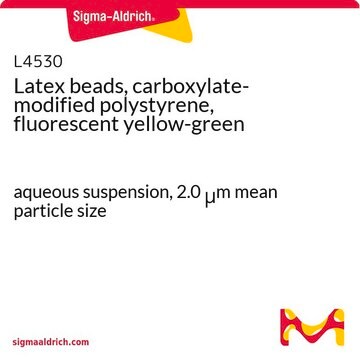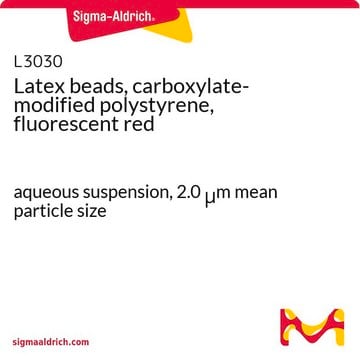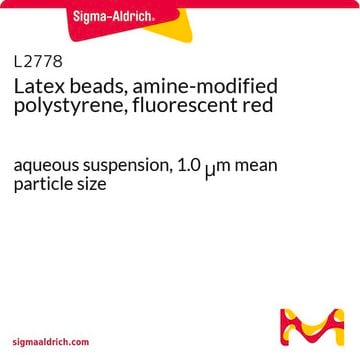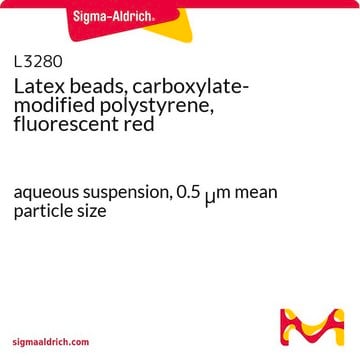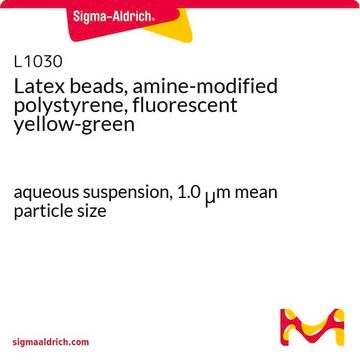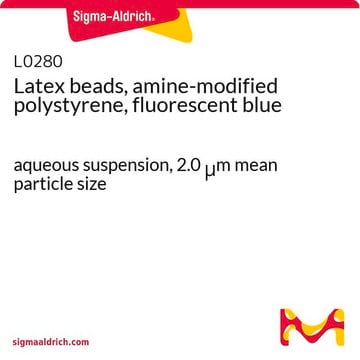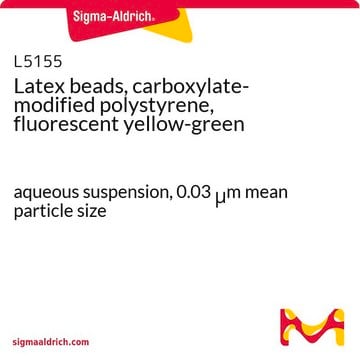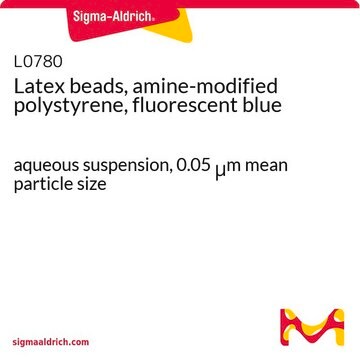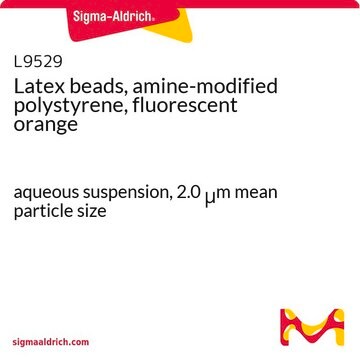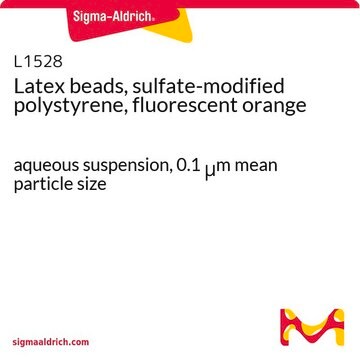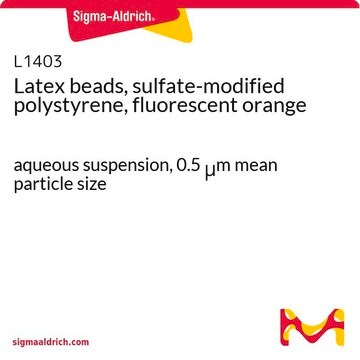The concentration of the Latex Beads is approximately 4.75x10^10 beads/mL.
L4655
Latex beads, carboxylate-modified polystyrene, fluorescent yellow-green
aqueous suspension, 1.0 μm mean particle size
Sinónimos:
Fluorescent Latex Beads
Seleccione un Tamaño
104,00 €
Seleccione un Tamaño
About This Item
104,00 €
Productos recomendados
Formulario
aqueous suspension
Nivel de calidad
composición
Solids, 2.5%
técnicas
cell based assay: suitable
tamaño medio de partícula
1.0 μm
fluorescencia
λex ~470 nm; λem ~505 nm
idoneidad
suitable for immunoassay
aplicaciones
cell analysis
¿Está buscando productos similares? Visita Guía de comparación de productos
Aplicación
- in epidermal growth factor conjugate preparation for indirect immunofluorescence imaging studies[1]
- for culturing mouse bronchoalveolar macrophages and human monocyte-derived macrophages prior to phagocytosis imaging studies[2]
- in coadministration with Salmonella expressed green fluorescent protein (GFP) for confocal microscopy studies and in biofluorescence imaging[3]
Código de clase de almacenamiento
10 - Combustible liquids
Clase de riesgo para el agua (WGK)
WGK 3
Punto de inflamabilidad (°F)
Not applicable
Punto de inflamabilidad (°C)
Not applicable
Elija entre una de las versiones más recientes:
¿Ya tiene este producto?
Encuentre la documentación para los productos que ha comprado recientemente en la Biblioteca de documentos.
Los clientes también vieron
-
What is the concentration of product L4655?
1 respuesta-
¿Le ha resultado útil?
-
-
What are the ingredients of the solution in which the plastic is diluted? Can I dilute it in PBS?
1 respuesta-
This product is prepared in water containing a prioprietary anionic surfactant and >0.1% Sodium Azide. Phosphate Buffered Saline is a suitable diluent.
¿Le ha resultado útil?
-
-
Are there latex beads recommended for phagocytosis, and if so, what size is recommended?
1 respuesta-
There is no performance testing of latex beads for phagocytosis. Information found indicates that internally, there are no specific protocols or recommendations for a phagocytosis method using the listed latex beads. However, references to literature where the products have been used in research are provided. The maximum excitation and emission for one of the latex bead products, L3280, are also mentioned. Additionally, three products (catalog numbers 59769, 43302, and 89904) were found on the company website, with variations in bead size and fluorescence. For more details, you may refer to the provided links and Knowledge Article 000007596.
¿Le ha resultado útil?
-
-
What are the differences between carboxylate-modified polystyrene and amine-modified polystyrene Latex beads, and which type of beads is suitable for phagocytosis applications?
1 respuesta-
When selecting beads for phagocytosis assays, there are three key parameters to consider: the size of the bead, the color of the bead (dyed or undyed), and the modification of the bead (carboxylate, amine, or sulfate modified).
Beads chosen for phagocytosis experiments typically range from approximately 0.5 to 3 micrometers in size. A 1:250 dilution of the beads into the culture medium is commonly used for phagocytosis experiments. Latex Beads, 2 um (Product No. L0905), can be utilized for phagocytosis assays, as macrophages can phagocytose particles larger than 2 um.
Fluorescent latex beads are available with different fluorescent dyes incorporated into the beads. The yellow-green beads are commonly used for phagocytosis studies and are compatible with most flow cytometers and fluorescent microscopes.
For phagocytosis applications, the choice of bead modification (carboxylate vs. amine) depends on the specific assay being conducted. Carboxylate-modified beads, with a negative charge, mimic the uptake of apoptotic cells, while amine-modified beads, with a positive charge, are used to mimic the uptake of opsonized cells.
¿Le ha resultado útil?
-
-
What is the recommended storage temperature?
1 respuesta-
This product may be stored at room temperature. For products with no specified storage temperature given on the label or product page, ambient storage may be assumed. Products that require controlled temperature storage, such as refrigeration or freezer conditions, storage temperatures are published on the product label, Certificate of Analysis, the Safety Data Sheet (SDS).
¿Le ha resultado útil?
-
Filtros activos
Nuestro equipo de científicos tiene experiencia en todas las áreas de investigación: Ciencias de la vida, Ciencia de los materiales, Síntesis química, Cromatografía, Analítica y muchas otras.
Póngase en contacto con el Servicio técnico